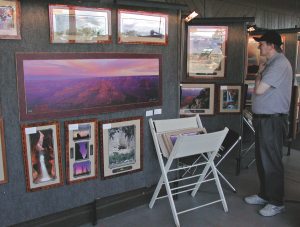
As artists we cannot hope that luck will bring us money and fame. We must be active in the marketing process. Taking control of your own marketing process ensures that specific things will happen because of your actions, your decisions, and your personal abilities, not because of some unknown outside force that may or may not come your way. It is this choice that will, eventually, will bring you success.
While it does not happen overnight, effectively marketing your art can lead to great success. Considering the following notes on marketing fine art photography will surely get you started:
1. Marketing considerations must come after the final image is completed. Marketing considerations often involve focusing on specific locations or subjects because they are popular, but such an approach forfeits focusing on your personal style. Doing so causes the artist to move away from the creation of fine art to focus on the creation of commercially oriented art.
Instead, focus on your vision and emotion during the creation process, and consider the marketing process only after the work is completed. This assures that your style is developed on the basis of your vision and your personality rather than on the basis of what the buying public likes. This approach is far more likely to result in the creation of fine art pieces that reflect a true personal style. In turn, this style will allow you to command higher prices for your work than you would have been able to if your work had been commercially oriented.
 2. Fine Art is not priced on a cost-of-goods basis. Fine Art is not priced on the basis of what it costs to make it. If it were, a Picasso would cost only a couple hundred dollars because paint, canvas, and stretcher bars are relatively inexpensive.
2. Fine Art is not priced on a cost-of-goods basis. Fine Art is not priced on the basis of what it costs to make it. If it were, a Picasso would cost only a couple hundred dollars because paint, canvas, and stretcher bars are relatively inexpensive.
The cost of goods is what it costs you, in supplies and materials, to create a specific piece. Your time is not included because it is not a tangible good. After calculating your cost of goods, you know exactly how much each piece cost you to create. The first time an artist does this they might be surprised at how low the figure is. However, this marketing approach is correct. Pricing should be based on how much time it took you to create the piece, plus the leverage of your reputation. 
3. A professional artist charges for his or her time. Your time is valuable. No matter who you are, rich or poor, famous or unknown, we all have 24 hours in a day and not a minute more. Since you cannot make more time, you have to charge for your time when it is used to serve somebody else’s needs. You need to figure out how much you want to charge for your time. To do this, set an hourly rate and apply this rate to the number of hours you spend working on specific projects.
4. An artist increases income by increasing prices, not by increasing output. In the business of selling art, increasing your income is achieved by increasing your prices. As we saw earlier, you cannot increase your output without lowering quality or creating an “art factory.” While creating a factory is certainly an option, and while a number of artists have done so successfully, it is not everyone’s cup of tea. Remember: The best way to increase your income without becoming a factory is to increase your prices.
From the book, Marketing Fine Art Photography by Alain Briot.
View all Rocky Nook’s books here.
